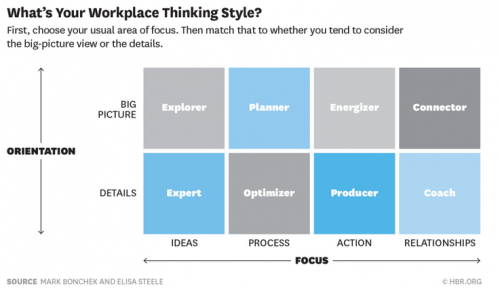What’s your thinking style? Just like we have personality preferences for introversion and extraversion, we also have preferred ways of thinking about a problem. There’s an interesting article about this from Harvard Business Review, November 25, 2015: “What Kind of Thinker Are You?” by Mark Bonchek and Elisa Steele.
Understanding how you think and how your teammates think could be key for groups who must work together effectively. When you consider successful teams, although they are measured on what they produce, they function better when they have diverse thinking styles. Instead of assigning teams based on personality traits, skills and strengths, managers might want to evaluate how potential members think.
Research shows that it is ultimately how teams think together that most determines their performance.
But in today’s marketplace, the smartest companies aren’t those that necessarily out-produce the competition. Instead, it’s the organizations that outthink them. And while there are plenty of tools that help us quickly understand what our teammates do, it’s harder to tell how they think. ~ Mark Bonchek and Elisa Steele
One aspect of collaboration is getting people aligned in what they do, and another is getting them aligned in how they think. How do you assess for thinking styles? After a lot of co-creation and trial-and-error, the authors, Bonchek and Steele, developed a three-step method that delivers practical and meaningful results.
I share with you here their ideas on assessing thinking style.
- Focus. The first step is to identify the focus of your thinking in a particular context or setting. Do you tend to pay the most attention to ideas, process, action, or relationships?
- Orientation. The next step is to notice whether your orientation in that setting swings toward the micro or the macro — the big picture or the details.
- The third step is to combine these two dimensions and see the thinking style at work in whatever context or setting you chose.
For example, on the big picture or macro orientation:
- Explorer thinking is about generating creative ideas.
- Planner thinking is about designing effective systems.
- Energizer thinking is about mobilizing people into action.
- Connector thinking is about building and strengthening relationships.
Across the micro or detail orientation:
- Expert thinking is about achieving objectivity and insight.
- Optimizer thinking is about improving productivity and efficiency.
- Producer thinking is about achieving completion and momentum.
- Coach thinking is about cultivating people and potential.
I find this interesting, what about you? I’ve never thought about my thinking style, but it does make sense that if we are going to form a team that works well together, we should ensure diversity in thinking while paying attention to alignment of purpose. According to the authors:
As a real-world demonstration, one company had their entire leadership team identify their thinking styles as managers and leaders. Looking at a heat map of the results, they realized they had a lot of big-picture Explorer thinking and a lot of Action thinking (Energizer and Producer), but very little Process thinking (Planner and Optimizer). The team was strong at coming up with big ideas and mobilizing everyone into action, but weak at working out the details and making things run efficiently.
What do you think? I’d love to hear from you. You can contact me here or on LinkedIn.

Did You Enjoy This Article?
Join thousands of other smart business owners like yourself & get our Proffittable Times newsletter.
It's filled with actionable content you can apply immediately.
Sign up now to get started!
– Coach Nancy










